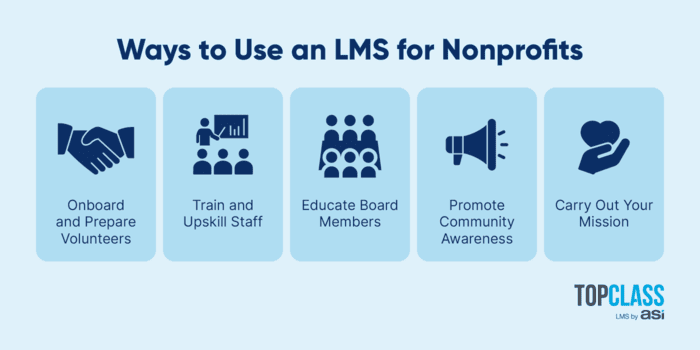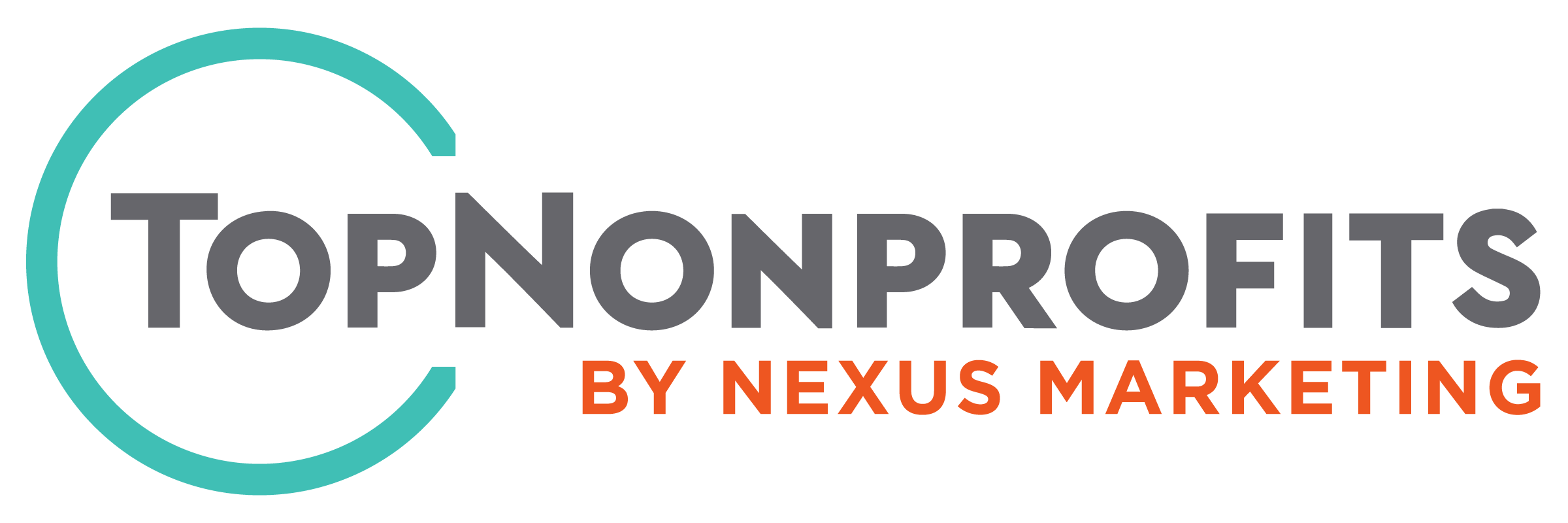Your nonprofit’s team is no stranger to change. To continue fulfilling your mission, you must stay on top of shifting community needs, donor preferences, regulatory requirements, and technology trends. That’s why investing in continuous learning is vital to your long-term success.
TopClass defines a learning management system (LMS) as “an online platform that makes it easy for organizations to design, manage, and track educational, training, and certification programs.” It’s the perfect solution for forward-thinking nonprofits that want a streamlined way to upskill their team, educate stakeholders, and amplify their impact with innovative strategies.
Should your organization implement an LMS? Explore these frequently asked questions to find your answer.
How can nonprofits use an LMS?
There are several ways in which an LMS can support your nonprofit’s goals. For example, you can use it to:

- Onboard volunteers. Make a strong first impression by designing a consistent, structured onboarding process. Upload welcome videos, self-paced modules, and role-specific courses to the platform. Use discussion boards and forums to build a sense of camaraderie among new and long-time volunteers.
- Train staff. Centralize all staff training resources online by setting up learning paths for various roles and departments. Help staff members sharpen their knowledge and develop new skills to power your mission by offering optional courses on topics ranging from search engine optimization (SEO) to accounting.
- Educate board members. Your nonprofit’s board oversees your financial performance, ensures the organization maintains regulatory compliance, and makes strategic decisions to improve your operations. Prepare them to fulfill these duties and participate in fundraising with online courses they can take on their own schedule.
- Promote community awareness. One of the first steps to securing support for your nonprofit is educating potential donors about the importance of your cause. With an LMS, you can create free courses related to your mission, from ocean sustainability to financial literacy—eventually turning curious community members into passionate advocates.
- Carry out your mission. An LMS can facilitate your nonprofit’s programs and services. For example, a youth development organization might develop online reading or coding courses to prepare students for long-term success and track individual progress on the platform.
Plus, according to iMIS’s member engagement guide, e-learning courses and certifications are some of the top benefits that associations and nonprofits can offer their members. If your organization runs a membership program, an LMS can help you enhance its value and entice more people to join.
What are some common features of a nonprofit LMS?
While there are many LMS options available for nonprofits, they should come with these basic features:
- A learning dashboard that users can access to explore available courses, track their progress, and view their achievements
- The ability to support multiple types of content like webinars and timed assessments to appeal to varying learning preferences
- Collaborative learning tools that bring learners together, such as discussion forums and cohort-based classes
- Secure payment processing that allows learners to make course purchases directly through the platform
- Assessments that accommodate multiple-choice, fill-in-the-blank, and essay questions
Additionally, you should be able to track performance metrics related to your learning program, such as the number of active users, average time spent on courses, and test results. With this information, you can make data-driven decisions to improve how you use your LMS to engage your community.
What should you consider when choosing an LMS?
When looking for the right LMS for your nonprofit, collect input from your organization’s staff and volunteers. Their feedback will give you insight into how the platform could impact different roles and responsibilities. Then, set a budget that you can reference throughout the research process.
Use the following considerations to guide your decision-making:
- Ease of use. The platform should be simple for administrators and learners to navigate, with quick loading times and a well-designed interface.
- Scalability. As your nonprofit adds more courses and learners to its program, your LMS should scale with your growth and handle increased data volumes without sacrificing performance.
- Learning pathways. The platform should make it easy to design customized pathways to guide learners through a structured sequence. Plus, you should be able to bundle courses as needed for certifications and credentialing programs.
- Integrations. Your LMS should connect with key tools, such as Salesforce, Zoom, or membership management software like iMIS, to create a seamless user experience.
- Support. While your LMS should be user-friendly, the provider should still provide expert support. See whether they offer any training resources to get your team up and running with the platform.
- Cost. Consider the license, setup, and support fees associated with each LMS. There are open-source learning platforms without license costs, but these do not offer any support for implementation or troubleshooting.
Finally, explore reviews online to learn about the experiences of other nonprofits that use the LMS. Use these insights to narrow down your list, then request demos to see how each platform works firsthand.
How do you implement a nonprofit LMS?
Selecting an LMS is an exciting first step for your nonprofit. The next step, implementation, sets the stage for how your administrators and learners will engage with the platform going forward.
Keep these tips in mind for a smooth LMS implementation:
- Create a dedicated implementation team. Designate a team leader to oversee the entire project and a project manager to handle the implementation plan. Gather representatives from across your organization to keep all your priorities front and center. This implementation team will collaborate with the vendor’s team to ensure all your goals are met.
- Announce your new LMS in advance. Start building excitement for your new learning opportunities among staff, volunteers, board members, donors, and the broader community. Design a webpage that summarizes the various courses you’ll offer. Craft email newsletters and social media posts highlighting all the ways in which learners can engage with your educational content.
- Clearly communicate throughout the process. Implementing an LMS is a team effort. Keep everyone on the same page by scheduling weekly check-in meetings to share updates and answer any questions. Log all major decisions and progress in a shared document for future reference.
While you may have ambitious goals for your learning program, start small and be patient. With careful planning and an improvement mindset, your entire community will soon experience the benefits of your educational offerings.
An LMS can transform how your nonprofit engages its team, donors, and other stakeholders in its mission. To refine your educational strategy, send out learner surveys to find out what course formats and topics they’re most interested in. From sharing nonprofit podcasts to enrolling your staff in fundraising certification programs, the sky’s the limit!
